United States Playing Card Company
The United States Playing Card Company (USPC, though also commonly known as USPCC), established in 1867 as Russell, Morgan & Co. and founded in its current incarnation in 1885, is a large American producer and distributor of playing cards. Its brands include Bicycle, Bee, Tally-Ho, Congress, Hoyle, Aviator, Aristocrat and KEM.[1] It also produces novelty and custom cards, and other playing card accessories such as poker chips. The company was once based in Cincinnati, Ohio, but is now headquartered in the Cincinnati suburb of Erlanger, Kentucky.
 | |
| Subsidiary | |
| Industry | Playing card manufacturer |
| Founded | 1867 |
| Headquarters | , |
Key people | Michael Slaughter (President) |
| Products | playing cards |
| Revenue | |
Number of employees | 750 |
| Parent | Cartamundi |
| Divisions | International Playing Card Company Limited |
| Website | www |
In December 2019, The United States Playing Card Company became a subsidiary of Belgian card manufacturer Cartamundi.[2]
History
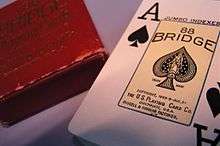
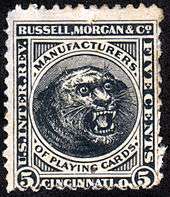

The company was founded in 1867 as Russell, Morgan & Co., a printing company.[3] In 1881, Colonel Robert J. Morgan, recruited a talented, young inventor from New York named Samuel J. Murray, whose patented inventions increased the output of cards at the company's Norwood, Ohio plant fourfold and cut labor costs by 66 percent. Murray also created a two-sided enameling machine.[4]
The company began printing four brands of playing cards in 1881: Tigers (No. 101), Sportsman's (No. 202), Army and Navy (both No. 303, No. 505 with gold edges), and Congress (No. 404, No. 606 with gold edges).[5] They began printing Bicycle cards, which would become their most popular line, in 1885.[6] Business boomed and in 1891 Russel, Morgan, & Co. changed its name to the United States Printing Company. The playing card business was successful enough that it was spun off as a separate business in 1894, as The United States Playing Card Company.[3]
The same year, the company began its long history of acquiring smaller playing card manufacturers when it acquired the Standard Playing Card Company, the Perfection Playing Card Company, and the New York Consolidated Card Company (makers of Bee and innovators of the "squeezer" card identifications in the corners: a design still in use today). Acquisitions continued throughout its history: Andrew Dougherty in 1907 (adding Tally-Ho), Russell Playing Card Co. in 1929 (adding Aristocrat), Heraclio Fournier, S.A in 1986, Arrco (formerly Arrow) Playing Card Company in 1987, Hoyle Products in 2001, and finally KEM Playing Cards in 2004. In 1930, USPC subsidiaries Consolidated Card Co., Standard Playing Card Co., and Andrew Dougherty merged into Consolidated-Dougherty which continued to produce cards from all three brands including Bee and Tally-Ho.
Meanwhile, the company would itself be acquired several times during its history: starting with Diamond International in 1969, Jessup & Lamont in 1982, Frontenac in 1989, and then a return to self-ownership in 1994 before finally becoming a subsidiary of Jarden which was in turn acquired by Newell Brands.
The USPC has historically supported wartime soldiers, starting with the inexpensive Canteen brand of cards during the Spanish–American War and the Pickett brand during World War I. During World War II, USPC manufactured spotter cards so soldiers could identify enemy units and cooperated with the U.S. Government in creating clandestine decks given to POWs; these cards could be moistened and peeled apart to reveal escape maps.
In May 2011, Marc Hill was named president of The United States Playing Cards Company.[7] In October 2011, the United States Playing Card Company in a partnership with Encore Software announced that they are launching the 2012 Hoyle product line - Hoyle Card Games 2012, Hoyle Casino Games 2012 and Hoyle Puzzle & Board Games 2012.[8]
In June 2019, Newell agreed to sell USPC to Belgian card manufacturer Cartamundi, including its two plants in Erlanger, Kentucky and Vitoria, Spain.[2]
Product lines
The company offers several card brands, including:[9]
500
The 500 (Or Five Hundred) brand was originally created by the National Playing Card Company as a "6 handed" 60-card rummy deck which includes 11-spot and 12-spot cards, as well as one joker. Eventually 500 decks also included 2 13-spot playing cards for the hearts and diamond suits, bringing up the total number of playing cards to 62 (excluding the joker). 500 playing cards have always been produced with the "air-cushion" finish. 500 playing cards have had 2 back designs during its production, notably one including a swastika, which was discontinued likely due to association with the Nazi Party. Originally it was stored in an ornate hard tuck case with gold lettering. Around the 1970's the fancier tuck cases were phased out. Sometime during the 1990's the unique box art was changed to a more bland design that says "500 Playing Card Game". It is currently produced and sold mainly for export to Australia.
Aladdin
The Aladdin brand was first produced by the National Card Company of Indianapolis in the 1880s. The stock number is "1001," although there is also a "1002" version, which is identical except that the 1002 features gilded edges. There is also a "1004" variant, which had no indices in the corners. At least four different back designs were produced, but it is unknown how many were produced, or for how long. Aladdins were retained and marketed by USPCC after USPCC acquired NCC. They are produced by USPCC today primarily for export. The cards are said to be designed to withstand the constant humidity and heat of Singapore. They are produced with a "smooth finish" and an "air-cushion" finish.
Aristocrat
The Aristocrat brand was created in 1915 by the Russell Playing Card Company of New York, which was acquired by the USPC in 1929. It was best known for its higher quality of card stock and varied but always intricate scroll work, in particular the "bank note" back, which resembled the design of currency notes at the time it was introduced, as Russell had acquired the playing card business of the American Bank Note Company in 1914. While the cards sold to the public carried the unique scroll-work, Aristocrat also produced the "Club Special" line of Aristocrat cards specifically for casinos. These were similar to Bee cards in that their backs were borderless with a diamond pattern and could optionally have casino logos added to the backs. Aristocrat was discontinued as a retail brand in the 1980s, but continues to be used for direct sales to casinos.[10]
Aviator
Introduced in 1927 in commemoration of Charles Lindbergh's trans-Atlantic flight in the Spirit of St. Louis, Aviator playing cards (stock No. 914) feature a bordered, monochrome back design of predominantly circles. They are less expensive compared to Bee and Bicycle as the card stock is thinner and has a smooth finish, unlike the textured "air-cushion" finish used in many of the company's other brands. Until around 1989, the Aviator Ace of Spades and Joker carried no specific branding. Aviator cards were often used as a generic card for limited-run promotional/advertising decks. They also were used to fill boxes of cards primarily sold for export or for military use. Brands such as Caravan, Torpedo, Mohawk, Battle Axe, Uncle Sam, and Tuxedo were generally filled with Aviator cards, and a few of these brands are still sold in other countries.
Bee
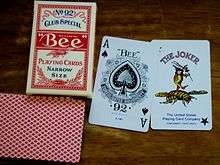
Bee is a casino card brand also sold at retail. They were first manufactured by the New York Consolidated Card Company in 1892, hence the number "92" on the Ace of Spades; the USPC acquired the company two years later, but it continued to operate independently, even after merging with Andrew Dougherty and Standard Playing Card Company to form Consolidated-Dougherty. Standard Bee playing cards have a diamond back, typically blue or red, though casinos frequently use customized Bee cards featuring a logo added to the various colored backs. Unlike Bicycle cards, Bee cards usually have borderless backs, making the facing of any card that is even partially revealed clearly visible. However, the standard diamond back of the card is very regular and low-profile compared to other back designs, which simplifies "bottom-dealing" and some other forms of sleight-of-hand.
Bicycle
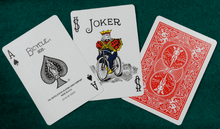
Bicycle Playing Cards (stock No. 808) are the USPC's flagship brand of cards, introduced in 1885.
The typical Bicycle deck is a standard deck of cards consisting of 52 traditional French-suited playing cards, two jokers, an information card, and a card describing poker ranks. The Bicycle trademark is printed on the ace of spades. The type number of a Bicycle deck can be found both on the bottom of the deck box and on the stone of the joker artwork. Bicycle cards have a textured 'air cushion' finish for improved handling.
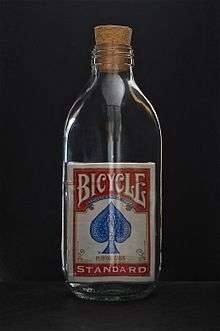
Bicycle cards are sold in poker and bridge widths, with additional deck configurations for use in other games such as pinochle, rummy, and canasta. Back designs include the standard 'Rider' back, the 'Vintage' back modeled on the original card design, and many specialty designs. Back colors include traditional red and blue, along with black, silver, and pastel colors. Face designs include standard, jumbo index, low-vision cards for the visually impaired, and a 'PokerPeek' design on their pro-series decks that simplifies looking at hole cards. Novelty 'Big Bicycle' cards that are four times the normal card size, and mini-sized cards are also available.
Bicycle playing cards are commonly used by magicians in card magic and flourishes due to their ordinary appearance.[11] In addition to specialty decks specifically designed for magic, cardistry or purely aesthetic reasons, USPC also make other kinds of non-standard card decks, such as a gaff deck (contained in a mirrored-art box) with an assortment of unusually altered cards that can be used with regular cards for tricks.
Starting in 2019, Bicycle started a "Games by Bicycle" division to enter into the hobby board game market, with party games and light strategic games using playing-card sized cards. These include Tattoo Stories, It's Blunderful, and Shuffle Grand Prix.[12] [13].
Subject to certain guidelines, the Bicycle brand can be licensed from USPC.[1]
Congress
Congress was the most expensive of the first four brands introduced by the company in 1881, when it was still known as Russell, Morgan, and Co. Congress was printed under two stocks: their standard No. 404 and the deluxe No. 606 which had gold edges.
In modern use, the Congress brand is used for contract bridge and canasta cards and accessories. Congress cards are available in a wide assortment of back designs, and are typically housed in a velour covered box with a pull-out tray. Each Congress deck consists of the 52 standard cards, two jokers (which feature an image of the United States Capitol), and an information card describing bridge scoring. Congress cards are usually sold in coordinated sets of two decks to facilitate the common bridge practice of alternating decks between hands.
Fournier
Naipes Heraclio Fournier S.A. manufactures many different sets of playing cards, most for sale in Europe. Fournier cards are also common choices for casinos around the world. In addition to their signature No. 1 Spanish playing cards, they also produce poker cards (the No. 18 line), tarot cards, and specialty cards. Since their acquisition by USPC, Fournier has also made use of the Bicycle brand name to distribute special-edition decks featuring unique artwork. They have also taken advantage of USPC's acquisition of KEM's plastic card technology to sell all-plastic versions of their cards (No. 2100 is the all-plastic version of their No. 1).
Hoyle
The Hoyle brand was originally produced by the Brown & Bigelow Company in 1927, and for many years was the main competitor to USPC's Bicycle. The cards proved such a success that Brown & Bigelow's card division was renamed Hoyle Products in 1975. Hoyle's shell back design is well-recognized, but Hoyle's most iconic figure is its Joker: a colorful jester whose face (repeated atop his scepter) is an optical illusion. The USPC bought Hoyle Products from Brown & Bigelow in 2001, and like most of its other acquisitions, has kept the popular Hoyle brand in print.
KEM
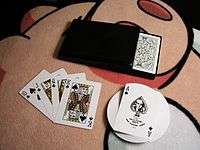
KEM cards were first manufactured in 1935. Unlike normal playing cards which are made from plastic-coated paper, KEM cards are made entirely from cellulose acetate and are waterproof. USPC purchased KEM Cards in 2004.[14][15] After a two-year hiatus, USPC restarted KEM card production, which continues today. KEM cards are available to the consumer (usually at specialty game shops) with various back colors and designs in both poker and bridge sizes. In 2007, KEM bridge cards (using Bicycle artwork) were adopted as the official cards of the World Series of Poker.
Maverick
Maverick was Hoyle's budget brand when it was acquired by USPC with the rest of Hoyle Products in 2001. It was introduced in 1959, during the run of the popular Maverick TV series. Unlike most USPC current product lines, Maverick is now being printed by outsourced manufacturers.
Streamline
Streamline came to the USPC from the Arrco Playing Card Company, longtime manufacturers of a large variety of low-end and budget-priced cards, which the USPC acquired in 1987. Streamline is a low-end brand, similar to Maverick, with a bordered monochrome back and a smooth plastic-coated finish. They are also produced by outsourced manufacturers.
Tally-Ho
Tally Ho was originally a product of Andrew Dougherty, one of the earliest American card manufacturers, introduced in 1885, the same year Bicycle was introduced. Dougherty's company was acquired by the USPC in 1907, bringing Tally-Ho into its assortment. Dougherty would then be merged with New York Consolidated Card Company and Standard Playing Card Company to form Consolidated-Doughterty. Tally-Ho cards come in two back designs, known as the "fan" back and the "circle" back, typically in traditional red and blue. Due to the unique finish, known as "linoid", and the distinct designs, they are popular for card flourishes.
Discontinued brands
Arrco
The Arrco Playing Card Company began operations in Chicago 1927 under the name Arrow Playing Card Company.[16] The company's founder, Theodore Regensteiner, helped popularized the Arrco brand by implementing a new easy-to-handle plastic coating for his decks. While Arrco sustained sales throughout the later half of the 20th century, the Regensteiner family decided to sell the company to USPC in 1987. The USPC continued to print the Arrco brand until it was discontinued in 2011.[16]
Army & Navy
One of the first five brands of cards introduced by the company in 1881, when it was still known as Russell, Morgan, and Co., Army and Navy were originally two separate brands although they shared the same two stock numbers: their standard No. 303 and the deluxe No. 505 which had gold edges. The two brands were then merged into the single Army & Navy brand in 1884. True to the name, the Joker and Ace of Spades of these brands tended to feature American military imagery, which changed over the years of its production.
Canteen & Picket
Stock No. 515, Canteen was issued during the Spanish–American War in 1898. They were of a low quality so as to be inexpensive and easily bought by the soldiers. It was discontinued shortly after the war. In World War I, the stock number was reused for Picket, another inexpensive brand which was again printed for sale to soldiers. Printing of Picket ceased after the Armistice.
Sportsman's
One of the first four brand of cards introduced by the company in 1881, when it was still known as Russell, Morgan, and Co., Sportsman's (stock No. 202) was a high-end brand of playing cards featuring a hunting motif. Production of these cards continued until 1936.[17]
Steamboat
The fifth brand of cards introduced by the USPC (stock No. 999, introduced in 1883), this brand was introduced to meet a growing demand for inexpensive playing cards (at the time of their introduction, Steamboat cards were available for as little as 5¢ a pack). Until they were discontinued early in the 21st century, Steamboat was the company's least expensive line of playing cards.[17]
Tigers
Stock No. 101, Tigers was the first brand published in 1881 and the cheapest of the earliest four brands. Its name comes from the tiger that appeared on the joker. After the introduction of the Steamboat line, the importance of Tigers was diminished. It was discontinued around 1930.[18]
Notes
- Flaherty, Joseph (February 7, 2013). "Designers, Classic Playing-Card Maker Win Big on Kickstarter". Wired. Archived from the original on August 13, 2016. Retrieved July 23, 2018.
- Griepp, Milton (June 10, 2019). "Cartamundi Will Acquire U.S. Playing Card Company". icv2.com. Retrieved July 26, 2019.
- "Company History". bicyclecards.com. Archived from the original on July 7, 2011. Retrieved January 14, 2011.
- "Samuel J. Murray is dead," Paper, Devoted to the Manufacture, Sale and Use of Pulp and Paper, Volume 16, September 1, 1915,. Google ebook, original from University of Michigan, digitized April 14, 2011. 1915. p. 28. Retrieved September 1, 2015.
- "Congress No. 606". wopc.co.uk. Retrieved January 17, 2011.
- "Bicycle No. 808". wopc.co.uk. Retrieved January 17, 2011.
- "Marc Hill Named President of United States Playing Card Company". PR Newswire. May 3, 2011. Retrieved December 15, 2018.
- "Encore Launches Hoyle Card Games 2012, Hoyle Casino Games 2012 and Hoyle Puzzle & Board Games 2012". Business Wire. October 18, 2011. Retrieved December 15, 2018.
- "United States Playing Card Company 2015 Product Catalog" (PDF). Retrieved September 2, 2018.
- USPCC Casino Catalog (PDF). April 2019. Retrieved July 22, 2019.
- Boyd, Gordon (2018). After Hours Magic: A Book of Al Thatcher Card Magic. Gary Thatcher. p. 23. ISBN 9781976900419.
- "GenCon Report: Games By Bicycle Rides In With Their Debut Titles". The Fandomentals. Retrieved November 4, 2019.
- "'BLUNDERFUL' AND 'SHUFFLE GRAND PRIX'". ICv2. Retrieved November 4, 2019.
- History of KEM cards. from kemcards.net
- History of Bicycle cards from bicyclecardgames.com
- Roya, Will (January 29, 2019). "The Iconic ARRCO Playing Cards". playingcarddecks.com. Retrieved July 2, 2019.
- "Vintage Back Designs of Non-Bicycle Playing Cards". jimknapp.com.
- Dawson, Tom; Dawson, Judy (2014). The Hochman Encyclopedia of American Playing Cards - Part 1 (2nd ed.). New York: Conjuring Arts Research Center. pp. 435–442.
External links
| Wikimedia Commons has media related to United States Playing Card Company. |